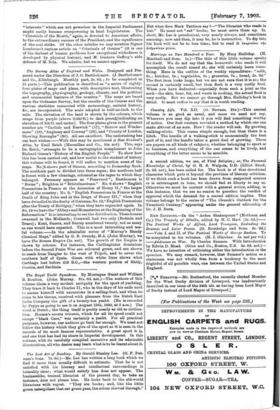The Survey Atlas of England and Wales. Designed and Pre-
pared under the Direction of J. G. Bartholomew. (J. Bartholomew and Co., Edinburgh. Monthly part, 2s. 6d.; to be completed in 21 parts.)—This publication is described as "a series of eighty- four plates of maps and plans, with descriptive test, illustrating the topography, physiography, geology, climate, and the political and commercial features of the country." The maps are based upon the Ordnance Survey, but the results of the Census and the various statistics connected with meteorology, natural history, &c., are incorporated. The scale adopted is half-an-inch to the mile. The elevation of the land is shown by the colours, which range from purple (above 3,000ft.) to dark greenl(indicating an elevation of 100 ft. and under). The four plates given in the present number are "Carlisle and Keswick" (17), 'Barrow and Winder- mere" (18), ".A.nglesey and Conway" (26), and "County of London, Showing Boroughs" (80). All are excellent. The undertaking has our best wishes.—With this may be mentioned A New Student's Atlas, by Emil Reich (Macmillan and Co., 10s. net). This, says Dr. Reich, "attempts to be a cartographic complement to John Richard Green's 'History of the English People." To show how this has been carried out, and how useful to the student of history this volume will be found, it will suffice to mention some of the maps. No.13 shows part of Sussex, according to Domesday Book. The southern part is divided into three rapes ; the northern half is forest with a few clearings, coloured as the rapes to which they belonged. Pevensey appears as " Peneverel" ; Eastbourne is " Borne " ; Brighton is" Bristelmestune." No. 6 shows "English Possessions in France at the Accession of Henry H.," the larger half of the country ; No. 9, "English Possessions in France at the Death of King John and in the Reign of Henry III.," when they have dwindled to the duchy of Guienne; No. 13," English Possessions after the Treaty of Bretigny," when they have expanded again. In No. 19 we have the "Abbeys and Monasteries at the Beginning of the Reformation." It is interesting to see the distribution. These houses swarmed in the Midlands; Cornwall had two only (Bodmin and Truro) ; Kent, Sussex, and Surrey numbered twenty, not as many as one would have expected. This is a most interesting and use- ful volume.—In the admirable series of "Murray's Handy Classical Maps," edited by G. B. Grundy, M.A. (John Murray), we have The Roman Empire (le. net). The growth of the Empire is shown by colours. For instance, the Carthaginian dominions before the Second Punic War are coloured green, and are shown to reach from Tangier to the west of Tripoli, and to cover the southern half of Spain. Green with white lines shows what Carthage lost before 218 B.C.,—the western portion of Sicily, Corsica, and Sardinia.










































 Previous page
Previous page